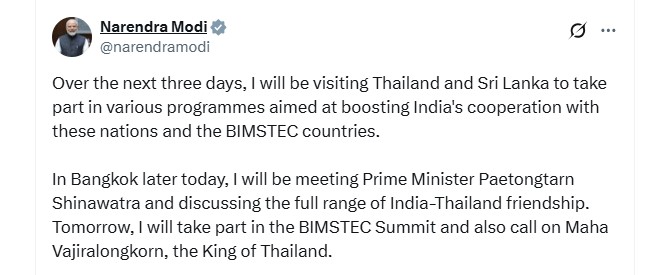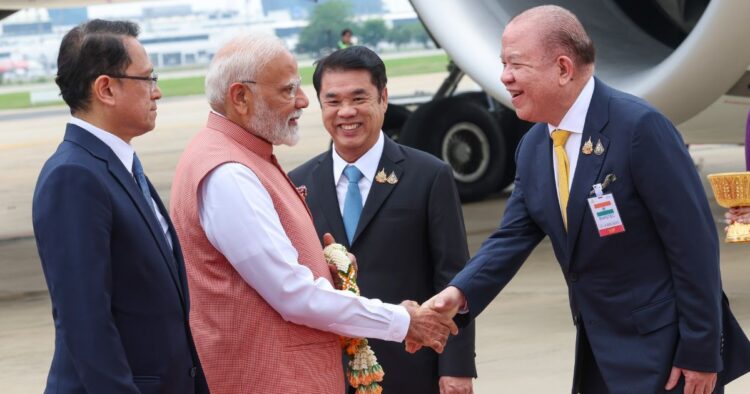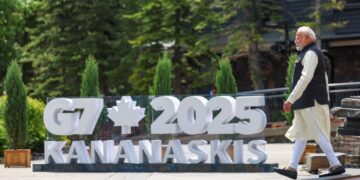- PM Modi visits Thailand for the 6th BIMSTEC Summit, focusing on security, trade, and regional cooperation.
- After the summit, Modi travels to Sri Lanka for a state visit, aiming to strengthen ties and sign key agreements, including a defense pact.
- India may join Thailand’s $29 billion “land bridge” project to improve trade routes across the Malay Peninsula.
Prime Minister Narendra Modi left for Bangkok, Thailand, on Thursday to attend the 6th BIMSTEC Summit, which will take place on April 4. After his visit to Thailand, he will travel to Sri Lanka for a state visit. Randhir Jaiswal, a spokesperson from the Ministry of External Affairs (MEA), shared this information on social media, saying, “PM @narendramodi has left for Thailand and Sri Lanka. He will attend the 6th BIMSTEC Summit before going to Sri Lanka.”

Ahead of his visit, PM Modi emphasised the significance of strengthening India’s cooperation with BIMSTEC nations. He wrote on X, “Over the next three days, I will be in Thailand and Sri Lanka to take part in various programs aimed at boosting India’s partnerships”.
Bilateral Meetings In Thailand
When Prime Minister Modi arrives in Bangkok, he will meet the Thai Prime Minister, Paetongtarn Shinawatra, to talk about how India and Thailand can work together. He will also meet the King of Thailand, King Maha Vajiralongkorn.
This will be Modi’s third visit to Thailand and the first time the BIMSTEC Summit is being held in person since 2018. The theme of the 6th BIMSTEC Summit is “BIMSTEC – Prosperous, Resilient, and Open.” The summit will focus on improving security, trade, investment, connections between countries, and people’s safety in the region.
State Visit To Sri Lanka
After attending the BIMSTEC Summit, Prime Minister Modi will visit Sri Lanka from April 4-6, at the invitation of Sri Lankan President Anura Kumara Dissanayake. Modi said that the visit comes after President Dissanayake’s successful trip to India, and he looks forward to discussing the relationship between the two countries and finding new ways to work together.
The visit aims to strengthen India’s relationship with Sri Lanka, a close neighbor with strong cultural and historical connections. With both BIMSTEC cooperation and India’s relationship with Sri Lanka in focus, this visit is expected to further improve India’s ties with its regional partners.
India And Sri Lanka Set To Sign Defence Pact
Indian Prime Minister Narendra Modi’s visit to Sri Lanka is seen as a move by India to balance China’s growing influence in the country. During this visit, India and Sri Lanka are expected to sign an important defense agreement.
The two countries will also finalize agreements on projects like setting up solar power plants, following up on discussions that started when Sri Lankan President Anura Kumara Dissanayake visited India in December.
India and Sri Lanka will also focus on strengthening their trade, especially in areas like textiles, medicines, and information technology. The defense deal is expected to be a major step in improving military cooperation between the two countries, including joint naval activities, exercises, and support for military equipment.
Modi will be the first foreign leader hosted by President Dissanayake, who took office last September. Experts say the visit is happening at a time when India and China are competing to build stronger ties with South Asian countries like Sri Lanka.
India Likely To Take Part In Thailand’s Land-Bridge Project
Prime Minister Modi and Thai Prime Minister Paetongtarn Shinawatra are expected to talk about India’s involvement in Thailand’s big project to build an 87-km highway and railway link across the Malay Peninsula. This project will connect the Andaman Sea and the Gulf of Thailand.
Thailand wants India to join in this $29 billion project, called the ‘land bridge.’ However, China is also interested in the project, seeing it as an alternative to the Strait of Malacca, which is an important sea route. If there is a conflict with China, India or the US could block this route.
Thailand is promoting the land-bridge project as a quicker, shorter, and cheaper way to move oil and other goods that are now shipped through the Strait of Malacca, a narrow waterway between the Malay Peninsula and the Indonesian island of Sumatra.

















Comments